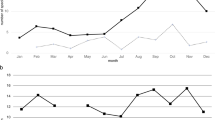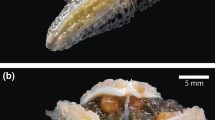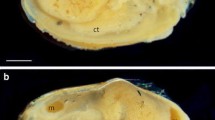Abstract
To improve early life stage identification of Octopus hubbsorum Berry 1953, embryonic development (stages I-XX), and complete morphological, morphometric, and meristic characters of its first day as a paralarvae are reported. Females were captured in Tenacatita Bay, Jalisco, Mexico (19°16′41.308″ N–104°47′37.046″W) in September 2017 and October 2018 and transferred to the laboratory for subsequent acclimatization and egg laying. For the first time, spawning behavior of the females, the early organogenesis of the species (stages I–XIV), and some of the stages recently observed in Octopus vulgaris Cuvier, 1797 were described in our specimens. Embryonic development lasted 18–22 d (at 28.3 °C mean temperature) giving rise to paralarvae with 1.55 mm mantle length (ML) (preserved paralarvae). Characters reported for the first time in paralarvae of this species are: beak with serrated edges and slightly pigmented, the rest of the beak is translucent; 7–8 gill lamellae in each demibranch; seven radular teeth and two marginal plates; and a chromatophore pattern different from that previously proposed for the same species. The chromatophore patterns identified in the present study are very similar to that proposed for Octopus mimus Gould 1852, in part supporting previously published genetic results indicating that O. hubbsorum and O. mimus should be considered the same species.











Similar content being viewed by others
Data availability
The datasets generated during and/or analyzed during the current study are available from the corresponding author on reasonable request.
References
Abbott RT (1954) American seashells. Van Nostrand Co, New York
Alejo-Plata MC, Gómez JL (2015) Reproductive biology of Octopus hubbsorum (Cephalopoda: Octopodidae) from the coast of Oaxaca, Mexico. Am Malacol Bull 33(1):89–100. https://doi.org/10.4003/006.033.0117
Alejo-Plata MC, Herrera-Alejo S (2014) First description of eggs and paralarvae of green octopus Octopus hubbsorum (Cephalopoda: Octopodidae) under laboratory conditions. Am Malacol Bull 32(1):132–139. https://doi.org/10.4003/006.032.0101
Alejo-Plata MC, Gómez-Márquez JL, Ramos-Carrillo S, Herrera-Galido JE (2009) Reproducción, dieta y pesquería del pulpo Octopus (Octopus) hubbsorum (Mollusca: Cephalopoda) en la costa de Oaxaca, México. Rev Biol Trop 57(1–2):63–78
Alejo-Plata MC, García-Guillén R, Herrera-Galindo J (2012) Paralarvas y juveniles de Octopus bimaculatus (Cephalopoda: Octopodidae) en el Pacífico sur de México. Rev Biol Mar Oceanogr 47(2):359–365. https://doi.org/10.4067/S0718-19572012000200019
Arocha F (1989) Estudio comparativo de rádulas de Octopus mediante el uso de microscopio electrónico de barrido. Acta Cient Venez 40(2):130–137
Berry SS (1953) Preliminary diagnosis of six west American species of Octopus. Leaf Malacol 1(10):51–58
Boletzky SV (1977) Post-hatching behaviour and mode of life in cephalopods. Symp Zool Soc Lond 38:557–567
Boletzky SV (1987) Embryonic phase. In: Boyle PR (ed) Cephalopod life cycles, vol 2. Academic Press, London, pp 5–31
Boletzky SV (1992) Evolutionary aspects of development, life style, and reproductive mode in incirrate octopods (Mollusca, Cephalopoda). Rev Suisse Zool 99:755–770
Castro-Fuentes H, Olivares-Paz A, Quintana-Fellay A, Zuñiga-Romero O (2002) Descripción del desarrollo embrionario y paralarva de Octopus mimus (Gould, 1852) (Mollusca: Cephalopoda) en cautiverio. Estud Oceanol 21:13–25
De Silva-Dávila R, Hochberg FG, Lindgren AR, Franco-Gordo C (2013) Paralarval development, abundance, and distribution of Pterygioteuthis hoylei (Cephalopoda: Oegopsida: Pyroteuthidae) in the Gulf of California, México. Molluscan Res 33:50–64. https://doi.org/10.1080/13235818.2012.754148
Deryckere A, Styfhals R, Vidal EAG, Almansa E, Seuntjens E (2020) A practical staging atlas to study embryonic development of Octopus vulgaris under controlled laboratory conditions. BMC Dev Biol 20:7. https://doi.org/10.1186/s12861-020-00212-6
Diario Oficial de la Federación (2018) Acuerdo por el que se da a conocer la actualización de la Carta Nacional Pesquera. https://www.gob.mx/cms/uploads/attachment/file/334832/DOF_-_CNP_2017.pdf. Accessed 10 March 2022
Farías A, Cerna V, Navarro JC, Pino S, Uriarte I (2011) Efecto de la dieta de los reproductores sobre la fecundidad y composición bioquímica de los huevos del pulpo rojo patagónico (Enteroctopus megalocyathus Gould 1852). Cienc Mar 37(1):11–21
Fiorito G, Affuso A, Basil J et al (2015) Guidelines for the Care and Welfare of Cephalopods in Research—a consensus based on an initiative by CephRes, FELASA and the Boyd Group. Lab Anim 49(S2):1–90. https://doi.org/10.1177/0023677215580006
Franco-Gordo C, Ambriz-Arreola I, Kozak ER, Gómez-Gutiérrez J, Plascencia-Palomera V, Godínez-Domínguez E, Hinojosa-Larios A (2015) Seasonal succession of zooplankton taxonomic group assemblages in surface waters of Bahia de Navidad, Mexico (November 2010–December 2011). Hidrobiológica 25(3):335–345
Geiger DL, Marshall BA, Ponder WF, Sasaki T, Warén A (2007) Techniques for collecting, handling, preparing, storing and examining small molluscan specimens. Molluscan Res 27(1):1–50
Gould AA (1852) Reports of the United States Exploring Expedition, Vol. I. Mollusca and shells. United States Exploring Expedition during the years 1838, 1839, 1840, 1891, 1842 under the command of C. Wilkes 12:1–510
Gray JE (1849) Catalogue of the Mollusca in the British Museum. Part I. Cephalopoda Antepedia. Natural Museum History Library, London
Guerra A, Cortez T, Rocha F (1999) Redescripción del pulpo de los Changos, Octopus mimus Gould, 1852, del litoral chileno-peruano (Mollusca, Cephalopoda). Iberus 17(2):37–57
Hochberg FG, Nixon M, Toll RB (1992) Orden Octopoda (Leach, 1818). In: Sweeney MJ, Roper CF, Mangod KM, Clarke MR, Boletzky SV (eds) “Larval” and juvenile cephalopods: a manual for their identification. Smithsonian Institution, Washington D.C, pp 213‒282
Hoyle WE (1904) Reports on the Cephalopoda. Bull Mus Comp Zool 43(1):1–72
Jamieson AJ, Vecchione M (2020) First in situ observation of Cephalopoda at hadal depths (Octopoda: Opisthoteuthidae: Grimpoteuthis sp.). Mar Biol 167:82. https://doi.org/10.1007/s00227-020-03701-1
Jereb P, Roper CFE (2010) Cephalopods of the world. An annotated and illustrated catalogue of species known to date. Volume 2. Myopsid and Oegopsid Squids. FAO, Rome
Jereb P, Roper CFE, Norman MD, Finn JK (2016) Cephalopods of the world. An annotated and illustrated catalogue of species known to date. Vol 3. Octopods and Vampire squids. FAO, Rome
Joll ML (1978) Observations on the embryonic development of Octopus tetricus (Molluscs: Cephalopoda). Aust J Mar Freshw Res 29:19–30. https://doi.org/10.1071/MF9780019
Kozak ER, Franco-Gordo C, Palomares-García R, Gómez-Gutiérrez J, Suárez-Morales E (2017) Annual egg production rates of calanoid copepod species on the continental shelf of the Eastern Tropical Pacific off Mexico. Estuar Coast Shelf Sci 184:138–150. https://doi.org/10.1016/j.ecss.2016.11.012
López-Uriarte E, Ríos-Jara E (2009) Reproductive biology of Octopus hubbsorum (Mollusca: Cephalopoda) along the central Mexican Pacific coast. Bull Mar Sci 84(1):109–121
López-Uriarte E, Ríos-Jara E, Pérez-Peña M (2005) Range extension for Octopus hubbsorum Berry, 1953 (Mollusca: Octopodidae) in the Mexican Pacific. Bull Mar Sci 7(2):171–176
López-Uriarte E (2006) Ciclo vital y pesca del pulpo Octopus hubbsorum Berry 1953(Cephalopoda: Octopodidae) en la costa de Jalisco, México. Dissertation. Universidad de Guadalajara. Centro Universitario de Ciencias Biológicas y Agropecuarias. México
Monsalvo-Spencer P, Salinas-Zavala CA, Reynoso-Granados T (2013) Morfología de la membrana coriónica de los huevos de Octopus bimaculoides y Octopus hubbsorum (Cephalopoda: Octopodidae). Hidrobiológica 23(1):124–129
Naef A (1928) Cephalopoda. Embryology. Part I, Vol II (Final part of Monograph No.35). In: Bardi G, Friedlander & Sons (eds) Fauna and flora of the Bay of Naples, translated by the Smithsonian Institution Libraries, Naples, pp 268–293
Ortiz N, Ré ME (2010) The eggs and hatchlings of the octopus Robsonella fontaniana (Cephalopoda: Octopodidae). J Mar Biolog Assoc UK 91(3):705–713. https://doi.org/10.1017/S0025315410001232
Pliego-Cárdenas R (2009) Biología reproductiva del pulpo Octopus hubbsorum Berry, 1953 (Cephalopoda, Octopodidae) en la isla Espíritu Santo, Golfo de California, México. Dissertation, Instituto Politécnico Nacional
Pliego-Cárdenas R, Hochberg F, León F, De García FJ (2014) Barriga-Sosa I (2014) Close genetic relationships between two american octopuses: Octopus hubbsorum Berry, 1953, and Octopus mimus Gould, 1852. J Shellfish Res 33(1):293–303. https://doi.org/10.2983/035.033.0128
Pliego-Cárdenas R, García-Domínguez FA, Ceballos-Vázquez BP, Villalejo-Fuerte M, Arellano-Martínez M (2011) Reproductive aspects of Octopus hubbsorum (Cephalopoda: Octopodidae) from Espíritu Santo Island, southern Gulf of California, Mexico. Cienc Mar 37(1):23–32. https://doi.org/10.7773/cm.v37i1.1730
Robson G (1929) A monograph of the recent Cephalopoda based on the collections in the British Museum (Natural History). Part I, Octopodinae. Natural History Museum Library, London
Roper CFE, Sweeney MJ, Nauen CE (1984) FAO species catalogue. Vol 3 Cephalopoda of the world. An annotated and illustrated catalogue of species of interest to fisheries. FAO Fisheries Synopsis, Roma
Roper CFE, Voss GL (1983) Guidelines for taxonomic descriptions of cephalopod species. Mem Nat Mus Victoria 44:49–63. https://doi.org/10.24199/j.mmv.1983.44.03
Rosas C, Caamal C, Cázares R, Rodríguez D, Romero M, Chay D (2006) Manual preliminar para el cultivo del pulpo Octopus maya. https://dokumen.tips/travel/manual-preliminar-pulpo.html?page=1. Accessed 20 Jun 2023
SADER (2017) Baja California Sur 1er lugar en captura de pulpo del litoral del océano Pacífico y 3er a nivel nacional. Representación AGRICULTURA Baja California Sur Blog. https://www.gob.mx/agricultura/bajacaliforniasur/articulos/baja-california-sur-1er-lugar-en-captura-de-pulpo-del-litoral-del-oceano-pacifico-y-3er-a-nivel-nacional?idiom=es. Accessed 20 Jun 2023
Sauer WH, Gleadall IG, Downey-Breedt N et al (2019) World octopus fisheries. Rev Fish Sci Aquac 29(3):279–429. https://doi.org/10.1080/23308249.2019.1680603
Sweeney MJ, Roper CF, Mangod KM, Clarke MR, Boletzky SV (1992) “Larval” and juvenile cephalopods: a manual for their identification. Smithsonian Institution Press, Washington
Uriarte I, Espinoza V, Herrera M, Zuñiga O, Olivares A, Carbonell P, Pino S, Farías A, Rosas C (2012) Effect of temperature on embryonic development of Octopus mimus under controlled conditions. J Exp Mar Biol Ecol 416–417:168–175. https://doi.org/10.1016/j.jembe.2012.03.003
Valdez-Cibrián A, Díaz-Santana-Iturrios M, Landa-Jaime V, Michel-Morfín E (2020) First detection of an ocellate octopus in the Revillagigedos ecoregion, a biodiversity hotspot located in the Tropical East Pacific Province. ZooKeys 986:81–100. https://doi.org/10.3897/zookeys.986.53250
Van-Heukelem GF (1973) Growth and life span of Octopus cyanea (Mollusca: Cephalopoda). J Zool 169:299–315. https://doi.org/10.1111/j.1469-7998.1973.tb04559.x
Villanueva R, Norman MD (2008) Biology of the planktonic stages of benthic octopuses. Oceanogr Mar Biol Ann Rev 46:105–202. https://doi.org/10.1201/9781420065756
Young RE, Harman RF (1988) “Larva”, “paralarva” and “subadult” in cephalopod terminology. Malacologia 29(1):201–207
Young RE, Harman RF, Hochberg FG (1989) Octopodid paralarvae from Hawaiian waters. Veliger 32:152–165
Zaragoza N, Quetglas A, Moreno A (2015) Identification guide for cephalopod paralarvae from the Mediterranean Sea. ICES Cooperative Research Report No. 324
Acknowledgements
This manuscript is part of the bachelor's thesis of the first author Renato Ulises Montero Ruíz. Authors thanks to all the people involved in this study: the diver Martín Martínez Fonseca of the cooperative "Liberación campesina" for his technical help in the capture of the specimens; to M.S. Arnulfo Hernández, Dr. Víctor Hugo Galván Piña and Dr. María del Carmen Franco-Gordo that provided material support during the laboratory experiment; and to the team of students of the Marine Biology program of Centro Universitario de la Costa Sur, Universidad de Guadalajara: Fernando Vizuet Santiago, Pastora Contreras Medellín López, Carlos Rodríguez González, Diego González Sahagún, Alejandro Hernández García, Mauricio Razo López, Arturo Bocanegra Martínez, Cecilia Munguía Estrada and Tzunaly Reyes Granillo who assisted us unconditionally. The feedback from anonymous reviewers was appreciated and greatly improved earlier versions of the manuscript.
Funding
This work was supported by the Departamento de Estudios para el Desarrollo Sustentable de Zonas Costeras, Universidad de Guadalajara.
Author information
Authors and Affiliations
Contributions
Design of the experiment, laboratory preparation, maintenance of females in laboratory RUM-R and CAA-G. Specimen collection was performed by CAA-G and RUM-R. Data acquisition and analysis were performed by RUM-R, AV-C and ERK. RDS-D verified and supervised the description of the embryonic developmental stages, paralarvae morphology and chromatophore patterns, and embryonic and radulae images. The first draft of the manuscript was written by RUM-R and all authors commented and edited critically previous versions of the manuscript. All authors read and approved the final manuscript.
Corresponding author
Ethics declarations
Conflict of interests
All authors included in this study declare that they have no conflict of interest.
Ethical approval
Specimens were taken from the commercial extraction activity with permits for waters under federal jurisdiction on the coast of Jalisco (11401787315), Registro Nacional de Pesca y Acuacultura (RNPA). Care and experimental use of organisms for the study have been followed according to Fiorito et al. (2015) guidelines.
Additional information
Responsible Editor: R. Villanueva.
Publisher's Note
Springer Nature remains neutral with regard to jurisdictional claims in published maps and institutional affiliations.
Rights and permissions
Springer Nature or its licensor (e.g. a society or other partner) holds exclusive rights to this article under a publishing agreement with the author(s) or other rightsholder(s); author self-archiving of the accepted manuscript version of this article is solely governed by the terms of such publishing agreement and applicable law.
About this article
Cite this article
Montero-Ruíz, R.U., De Silva-Dávila, R., Amezcua-Gómez, C.A. et al. Description of the spawning, embryonic development, and paralarvae of the green octopus Octopus hubbsorum Berry 1953 (Cephalopoda: Octopodidae) under laboratory conditions. Mar Biol 170, 116 (2023). https://doi.org/10.1007/s00227-023-04260-x
Received:
Accepted:
Published:
DOI: https://doi.org/10.1007/s00227-023-04260-x




